There had been rain and sleet all night long. I arose, had a cold shower getting to the showers, then a lovely warm shower, followed by another cold shower walking back to the van. How invigorating. I didn't stop to make breakfast, I just cleared out. Butte had been an enigmatic place with a few odd people. I'm certain it held more secrets to explore, but I no longer felt comfortable there. It seemed a little insular in some ways, perhaps because it was based upon imported miners, but there again most of America started out with imports, so perhaps that is not the answer. It was certainly apart from the rest of what I had seen so far on my trip. Kevin had told me the day before that the rest of Montana hates Butte because Butte is strongly Republican, whereas the rest of Montana is staunch Democrat. I'll never know.
I drove onto the I90, the interstate highway that stretches all the way from Seattle in the west to Boston in the east. There was an immediate climb. I must have gained only 50m in height before I was driving through forests laced with powdery snow, and the higher I got the worse the snow storm had been. When I reached the Continental Divide again, the scene resembled one of Turner's snowstorm scenes; confused clouds dashing about doing their damnedest to wreak havoc. But this should be expected a mile and a half above sea level in the Rockies.
I dropped down from the Continental Divide, and found myself driving through a grassy plain with nothing to break the green uniformity for miles and miles. It is only when you see vistas like this that you start to realise just how big America is and how much space it contains. Occasional low hills would appear on the horizon, and they would pass below me and be left far behind as I entered yet another wide plain.
After an hour and half of driving I reached Livingston where I turned right and followed the Yellowstone River. On my right were the Gallatin Range of mountains, and on my left lay the Absaroka Range of mountains. The latter reared up abruptly like a long line of tobacco stained molars. Behind them was the Absaroka Beartooth Wilderness, the largest expanse of wilderness over 10,000' in the US. The valley was lush, and the river wide and fast flowing. As I approached Gardiner, more and more rafting outfits were encountered. I reached Gardiner, the last outpost before entering Yellowstone Park from the north end. This was a collection of gift shops, eating establishments and garages which made me glad I was off into the park almost immediately, or would be glad to skip through on the way out. One useful place to visit in Gardiner was the information centre. There I got leaflets on all the places to visit, and also advice on the campsites and roughly what time they are usually full by. This enabled me to do a quick calculation and settle on Norris campsite which lay roughly half way down the park on the western side.
I entered the park through the gate about half a mile further on, and bought a pass for all the National Parks, $80 + tax, which was valid for a year. This would save me a lot of expense since I would cover quite a few parks. Once in the park, my plan was to head for Mammoth Hot Springs first, then dash down for 20 miles to get a pitch in the campsite.
Yellowstone Park centres on a 7500ft-high plateau, created by a vast volcanic eruption 640,000 years ago. A huge underground chamber disgorged 240 cubic miles of molten rock, and then promptly collapsed upon itself, creating the Yellowstone caldera. Its rim measures about 47 miles by 28 miles at its broadest. Into it are crammed more than half the world's geysers, plus thousands of fumaroles jetting plumes of steam, mud pots gurgling with acid-dissolved muds and clays, and hot springs. Most of the park's geothermal features are within the caldera, as is much of Yellowstone Lake, but there is plenty of peripheral volcanic activity as well, as evidenced by the Mammoth Hot Springs and Norris Geyser Basin, both of which are outside the caldera boundary.
Mammoth Hot Springs
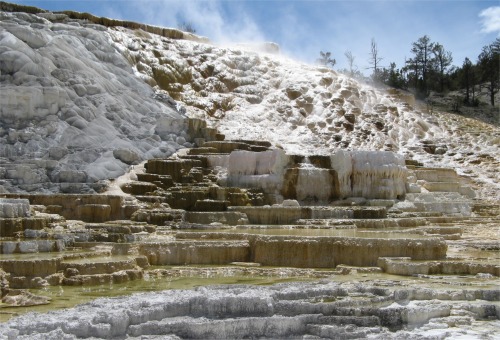
Palette Spring
|
Travertine terraces are found at Mammoth Hot Springs, where the dominant rock is limestone (calcium carbonate). The terraces reminded me of Pamukale in Turkey (Pamukale is Turkish for "cotton wool castle") where the springs are lukewarm and cascade down in glistening white pools where people can bathe. The limestone was deposited in the Yellowstone region millions of years ago when a vast sea covered the area, providing the raw ingredient. At Mammoth, a network of fractures and fissures form the plumbing system that allows hot water from underground to reach the surface. The water comes from rain and snow falling on the surrounding mountains and seeping deep into the earth where it is heated. The hot water with dissolved carbon dioxide makes a solution of weak carbonic acid. As the solution rises through rock, it dissolves calcium carbonate. At the surface, calcium carbonate is deposited as travertine, the chalky white rock of the terraces. Due to the rapid rate of deposition, these features constantly and quickly change.
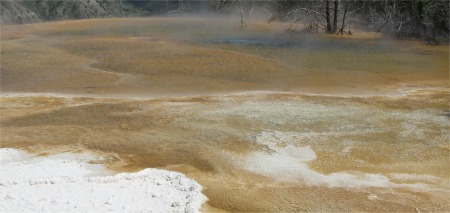
Bacterial Colours
|
A most distinctive feature of the hot springs is the amazing range of colours they exhibit, from aquamarine blues to fiery reds and oranges. Thermophiles (heat-loving microorganisms) create tapestries of colour where hot water flows among the terraces. The maximum water temperature found at the springs is 74 degrees C. Colourless and yellow thermophiles grow in the hottest water; orange, brown and green thermophiles thrive in cooler waters.
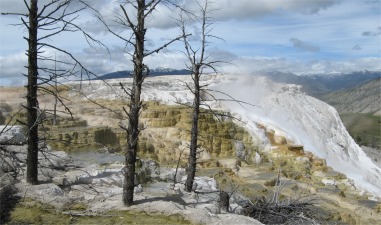
Dead Trees in the Springs
|
|
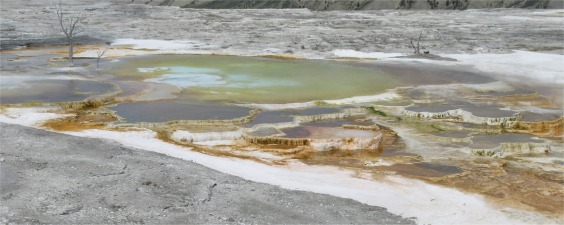
Multicoloured Pools
|
|
Over time some springs have become dormant, and soon soil forms on these areas and grass, wild flowers and trees take over the area. New springs form elsewhere to take their place, killing the trees as their 'veins' gradually calcify.
Norris Geyser Basin
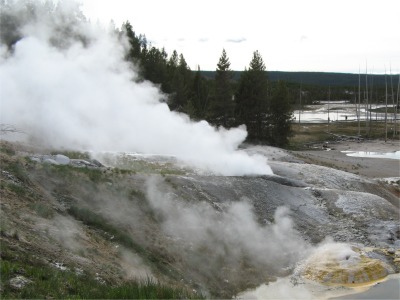
Black Growler Steam Vent
|
Norris Geyser Basin is one of the hottest and most dynamic of Yellowstone's hydrothermal areas. Many hot springs and fumaroles have temperatures above boiling point. Norris sits on the intersection of three major faults. One runs from the north; another runs from the west. These two faults intersect with a ring fracture from the caldera. Magma rises to within 2 miles of the surface under Norris, producing Yellowstone's hottest recorded temperatures. Barely 1000' below the surface, scientific instruments have recorded temperatures as high as 459 degrees F.
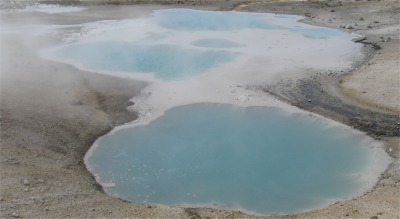
Porcelain Springs
|
Every year at Norris new hot springs and geysers appear; others become dormant. Geological events cause many changes. The geysers and hot springs create changes themselves. The mineral rich deposits can sometimes choke off the flow of water, and pressurised water may exploit a weakness elsewhere creating a new outlet.
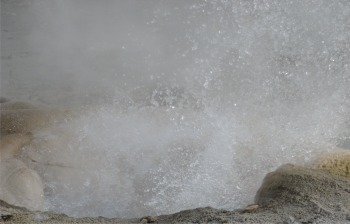
Veteran Geyser
|
|
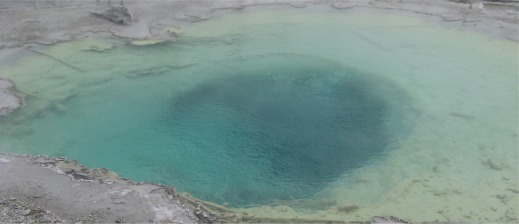
Cistern Spring
|
|
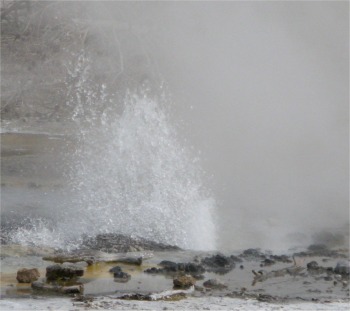
Quick Spurt
|
Various trails allowed me to explore Norris. Multiple signs warned people not to venture off the wooden walkways; often the chalky crust would be tenuously thin, and people have fallen through before, indeed 12 people had been scalded to death. In addition some of the water was so acidic that it dissolved boots. As I walked along I came across a huge variety of multi-hued pools, some still with steam rising off their surfaces, others simmering or boiling vigorously. A few were throwing jets of water about 1.5m in the air. There were areas where the surface just crackled like rice-crispies as thousands of small holes bubbled away. Fumaroles or steam vents were in abundance. They were the hottest hydrothermal features in the park. They had so little water that it all flashed into steam before reaching the surface. The fumaroles presented themselves audibly in a variety of ways. Smaller ones hissed like Roman candle fireworks, larger ones roared, from some a deep bellowing noise far underground could be heard, others appeared as rabbit holes with a hissing serpent deep inside. The cacophony of sound was splendid; hissing, roaring steam; gurgling, splooshing of geysers, and all the time a deep bellowing from far below. It was easy to believe I was standing on a volcano. Steam and the smell of sulphur was all around, like a scene from Dante's Inferno.
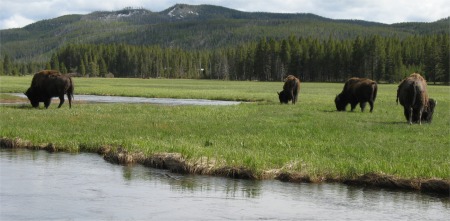
Bison by Norris Campsite
|
Once ensconced at the campsite, I wandered down to the riverside at one end of the site. The river meandered gracefully up a flat valley. On the other side of the river from where I was standing, a group of bison nonchalantly munched the grass. It was such a peaceful setting, and lots of families had brought their kids down to see the sight.
I cooked chilli con carne for tea; I needed the extra heat since the campsite was over 7500', and the temperature was dropping. There were indications of a 60% chance of snow tomorrow. Delightful.











